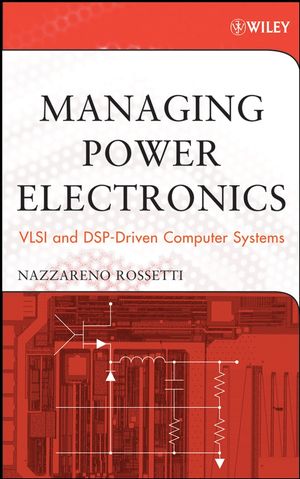Managing Power Electronics: VLSI and DSP-Driven Computer SystemsISBN: 978-0-471-70959-6
Hardcover
408 pages
November 2005, Wiley-IEEE Press
 This is a Print-on-Demand title. It will be printed specifically to fill your order. Please allow an additional 10-15 days delivery time. The book is not returnable.
|
||||||
A unique system focus that presents specific solutions for specific
appliances
This publication presents state-of-the-art power management techniques for modern electronic appliances that rely on such very large-scale integration (VLSI) chips as CPUs and DSPs. The author thoroughly covers all aspects of the field, including semiconductor manufacturing processes, packages, circuits, functions, and systems. A unique and significant contribution to the field, the publication adopts a "system focus" by first presenting the appliance and then delving into the power management architecture and topologies that best serve each appliance.
In addition to specific techniques and applications, the publication discusses fundamental physical and socioeconomic issues. For example, the author examines Moore's law and its effect on power management and heat dissipation, which points to a future breakthrough needed to continue the fast pace of advancement in the high-tech industry.
The author provides a solid technical foundation and an analysis of popular electronic appliances, including:
* Overview of the semiconductor industry
* Plain-English discussion of semiconductor processes and packages
* Step-by-step guide to analog design building from the transistor to higher-level functions, leading to the implementation of a complete voltage regulator
* Popular DC-DC voltage regulation architectures
* AC-DC architectures for power conversion
* Ultra-portable devices, such as cellular phones, PDAs, and digital still cameras
* Desktop and notebook PCs
The publication concludes with a chapter on special power management topics and an expert forecast of future directions for the field. This is essential reading for researchers, engineers, and designers in the semiconductor and integrated circuits industries. With its extensive use of cross-section drawings as well as transistor circuit schematics, this is also a recommended textbook for advanced undergraduate and graduate courses in computer science and electrical engineering.
This publication presents state-of-the-art power management techniques for modern electronic appliances that rely on such very large-scale integration (VLSI) chips as CPUs and DSPs. The author thoroughly covers all aspects of the field, including semiconductor manufacturing processes, packages, circuits, functions, and systems. A unique and significant contribution to the field, the publication adopts a "system focus" by first presenting the appliance and then delving into the power management architecture and topologies that best serve each appliance.
In addition to specific techniques and applications, the publication discusses fundamental physical and socioeconomic issues. For example, the author examines Moore's law and its effect on power management and heat dissipation, which points to a future breakthrough needed to continue the fast pace of advancement in the high-tech industry.
The author provides a solid technical foundation and an analysis of popular electronic appliances, including:
* Overview of the semiconductor industry
* Plain-English discussion of semiconductor processes and packages
* Step-by-step guide to analog design building from the transistor to higher-level functions, leading to the implementation of a complete voltage regulator
* Popular DC-DC voltage regulation architectures
* AC-DC architectures for power conversion
* Ultra-portable devices, such as cellular phones, PDAs, and digital still cameras
* Desktop and notebook PCs
The publication concludes with a chapter on special power management topics and an expert forecast of future directions for the field. This is essential reading for researchers, engineers, and designers in the semiconductor and integrated circuits industries. With its extensive use of cross-section drawings as well as transistor circuit schematics, this is also a recommended textbook for advanced undergraduate and graduate courses in computer science and electrical engineering.



